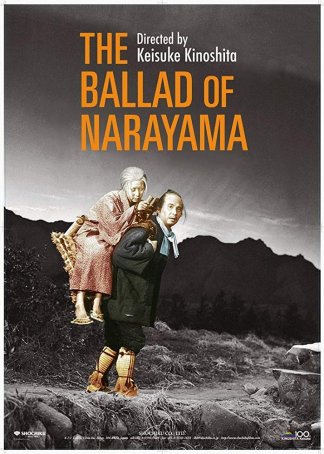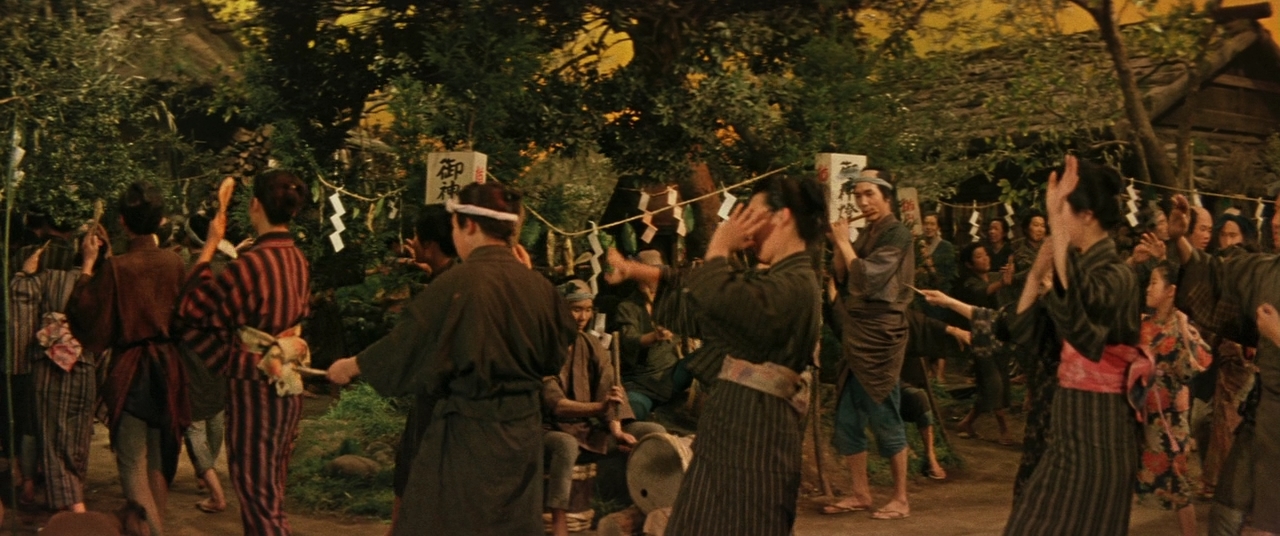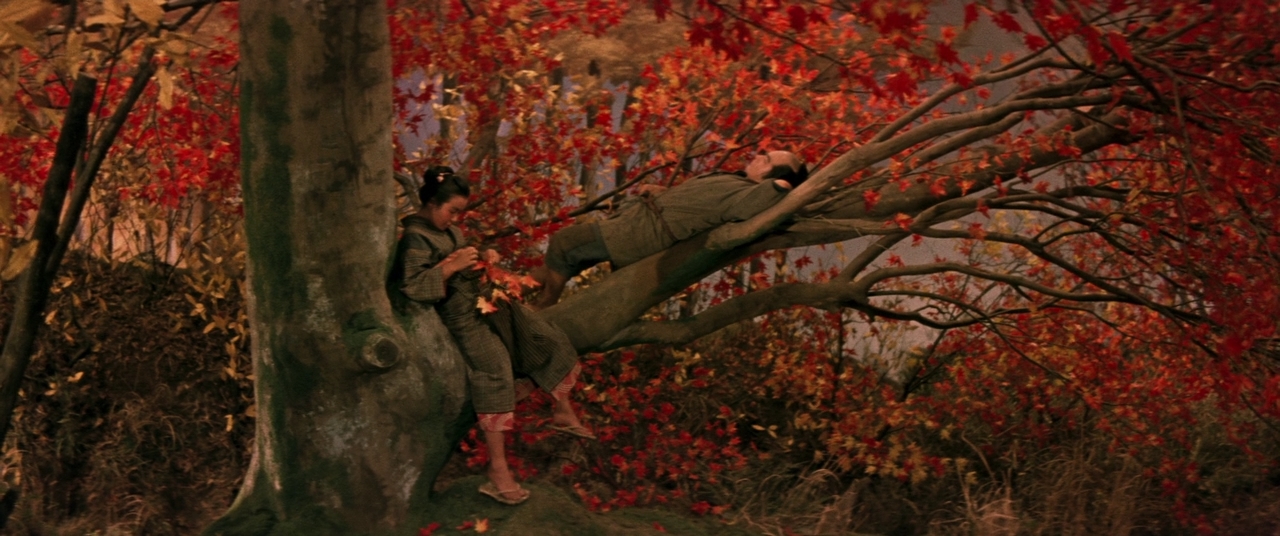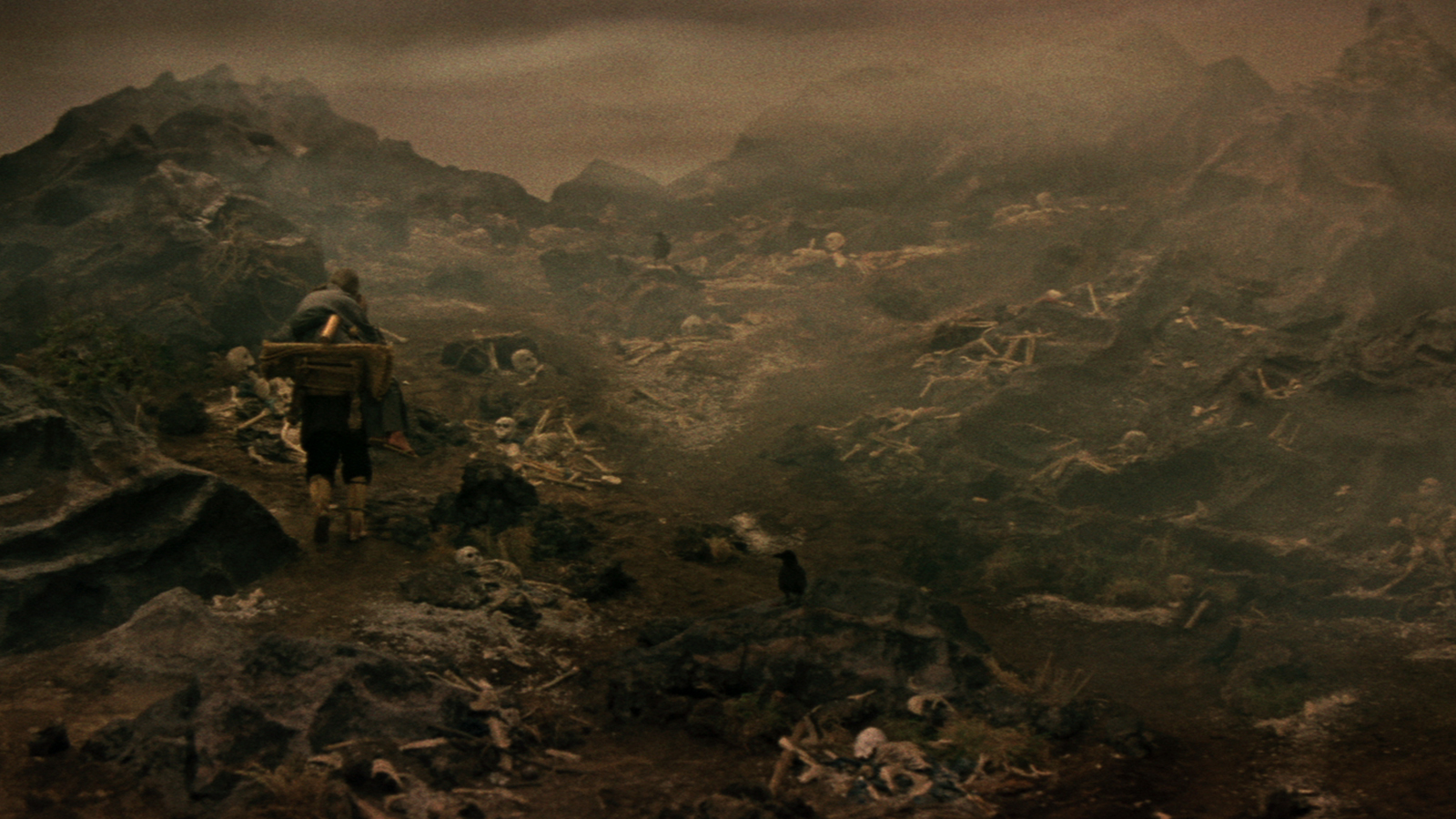Ballad of Narayama, The (Japan, 1958)
August 11, 2019
The Ballad of Narayama,
a 1958 Japanese film from director Keisuke Kinoshita, is revered in some
critical circles because of its extreme stylization – using the art of kabuki
theater to form a template for the exploration of Shichiro Fukazawa’s novel.
Roger Ebert, in one of his final reviews, awarded the film four stars, and he
was not alone in his praise for it. However, the reason why some critics laud
the production is why I don’t believe it works. Kabuki on film is a hard sell,
especially for a Western audience. (I am aware that there’s a cultural divide
involved here both in terms of the era when The
Ballad of Narayama was made and the tradition in which it exists.) Its
artifice creates a unique, theatrical aesthetic but that leeches away any
emotional connection with the characters. They are too obviously actors playing
parts – chess pieces being moved around by a filmmaker. We are aware of the
movie’s central tragedy on an intellectual level but it doesn’t touch us the way it should. As a result,
The Ballad of Narayama feels drawn-out,
like a film school short that has been stretched beyond its natural length.
The Ballad of Narayama
transpires in a remote Japanese village where food shortages have resulted
in a policy that, once someone turns 70, a close family member will carry them
up into the mountains to a place called “Narayama,” where they are left in the
open to die of exposure. There are rules associated with the activity – no talking
is allowed inside Narayama, no one must see the soon-to-be-dead person and
his/her caretaker depart, and the caretaker cannot look back once the deed is
done. Some embrace this more willingly than others, seeing it as a necessary
sacrifice and natural progression of life.
 One such person is Orin (Kinuyo Tanaka) who, as she
approaches her 70th birthday, speaks with anticipation of “going to
Narayama.” Death holds no fear for her. Her family is divided. Her son,
Tatshuei (Teiji Takahashi), is unwilling to face his part in the journey (he
will be the one to carry her). Orin’s grandson, however, is looking forward to
her being gone, since it will leave more food for him and his growing brood.
Meanwhile, in the same village, an elderly man, Mata (Seiji Miyaguchi),
approaches his end with less calmness and nobility. He doesn’t want to die and,
in the end, his son has to tie him up in order to get him to make the trip.
One such person is Orin (Kinuyo Tanaka) who, as she
approaches her 70th birthday, speaks with anticipation of “going to
Narayama.” Death holds no fear for her. Her family is divided. Her son,
Tatshuei (Teiji Takahashi), is unwilling to face his part in the journey (he
will be the one to carry her). Orin’s grandson, however, is looking forward to
her being gone, since it will leave more food for him and his growing brood.
Meanwhile, in the same village, an elderly man, Mata (Seiji Miyaguchi),
approaches his end with less calmness and nobility. He doesn’t want to die and,
in the end, his son has to tie him up in order to get him to make the trip.
The film is presented almost like a puppet show with live
actors taking the place of marionettes. This is especially evident during the
film’s visually arresting final 15 minutes, when there is almost no dialogue.
In order to convey strong emotions (especially with Kinoshita electing not to
use close-ups), the actors (notably Teiji Takahashi, who plays the son) employ
exaggerated movements similar to what one sometimes sees in stage plays (an
affectation necessary to inform viewers in the “cheap seats”). This type of
overacting was common during the silent era and carried over into the early talkies
but it’s surprising to see it in a 1958 production and is another result of
steeping The Ballad of Narayama in
the kabuki tradition.
 The style is an attempt by Kinoshita to present The Ballad of Narayama as a fable. While
most films strive for some degree of “reality” (at least within the universe
where they transpire), this one embraces its essential “surreality.” The
village is rendered on a soundstage (complete with a running brook) with
detailed matte paintings serving as backdrops. The Narayama location is
populated by black crows and the skeletal remains of those who have previously
arrived to do their duty. It’s a grim, foreboding place, especially once a thin
covering of snow blankets it. Kubuki trappings are everywhere, from the acting mannerisms
to the usage of a (singing) narrator to the unique musical score emphasizing
strings and percussion.
The style is an attempt by Kinoshita to present The Ballad of Narayama as a fable. While
most films strive for some degree of “reality” (at least within the universe
where they transpire), this one embraces its essential “surreality.” The
village is rendered on a soundstage (complete with a running brook) with
detailed matte paintings serving as backdrops. The Narayama location is
populated by black crows and the skeletal remains of those who have previously
arrived to do their duty. It’s a grim, foreboding place, especially once a thin
covering of snow blankets it. Kubuki trappings are everywhere, from the acting mannerisms
to the usage of a (singing) narrator to the unique musical score emphasizing
strings and percussion.
 The film’s look and feel are so pervasive that it’s easy to
lose sight of the great underlying tragedy. Obasute (referenced in the film’s
brief epilogue) is a Japanese legend about the abandonment of the elderly.
Kinoshita seeks to flesh out how this might have worked and the impacts it
would have had on those in the village who know the aging individual. Watching The Ballad of Narayama, it’s possible to
catch glimpses of the story’s power, but the style keeps interfering with the
narrative’s progression. In 1983, Shohei Imamura orchestrated a remake that
abandoned the kabuki elements and told the story “straight” (as in the source
novel). It won the Palme d’Or at Cannes.
The film’s look and feel are so pervasive that it’s easy to
lose sight of the great underlying tragedy. Obasute (referenced in the film’s
brief epilogue) is a Japanese legend about the abandonment of the elderly.
Kinoshita seeks to flesh out how this might have worked and the impacts it
would have had on those in the village who know the aging individual. Watching The Ballad of Narayama, it’s possible to
catch glimpses of the story’s power, but the style keeps interfering with the
narrative’s progression. In 1983, Shohei Imamura orchestrated a remake that
abandoned the kabuki elements and told the story “straight” (as in the source
novel). It won the Palme d’Or at Cannes.
For a casual film-goer with no special interest in kabuki or Japanese customs, The Ballad of Narayama has little to offer beyond the uniqueness of its presentation. Those seeking to learn more about the history of Japanese cinema and the influences of stage drama on its development will find value in The Ballad of Narayama. It works on a purely intellectual level, however, and is more useful for study than conventional viewing.
Ballad of Narayama, The (Japan, 1958)
Cast: Kinuyo Tanaka, Teiji Takahashi, Yuko Mochizuki, Danko Ichikawa, Seiji Miyaguchi, Keiko Ogasawara Director: Keisuke Kinoshita
Home Release Date: 2019-08-11
Screenplay: Keisuke Kinoshita, based on the novel by Shichiro Fukazawa
Cinematography: Hiroshi Kusuda
Music: Chuji Kinoshita, Matsunosuke Nozawa
U.S. Distributor: Films Around the World
- Sansho the Bailiff (1955)
- (There are no more better movies of Kinuyo Tanaka)
- (There are no more worst movies of Kinuyo Tanaka)
- (There are no more better movies of Teiji Takahashi)
- (There are no more worst movies of Teiji Takahashi)
- (There are no more better movies of Yuko Mochizuki)
- (There are no more worst movies of Yuko Mochizuki)

Comments